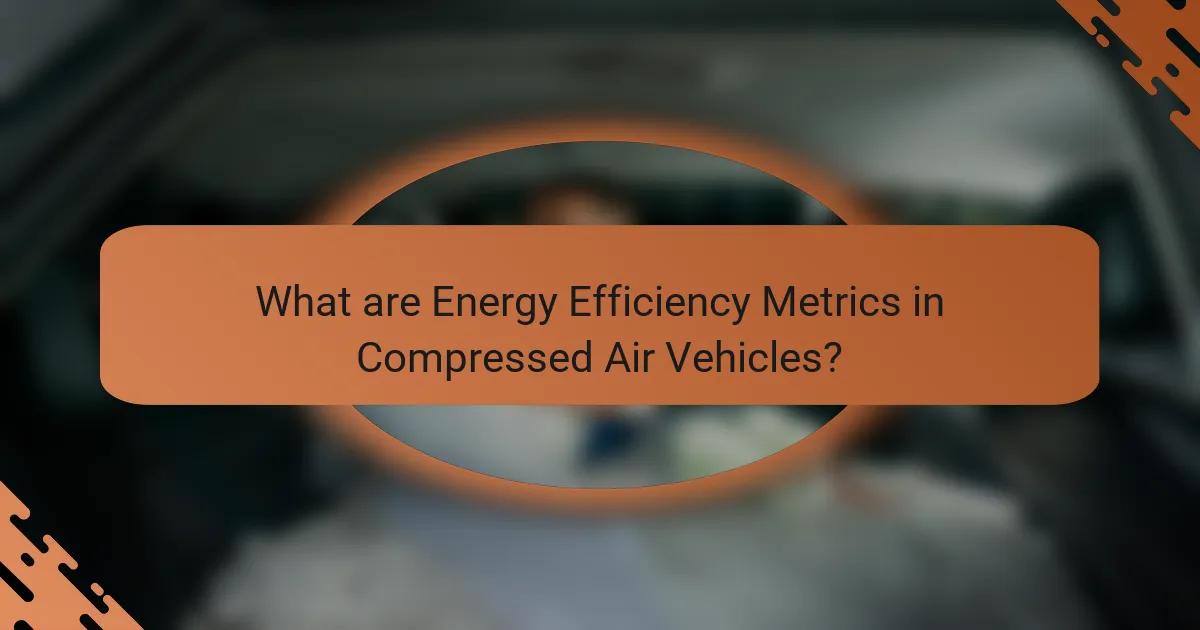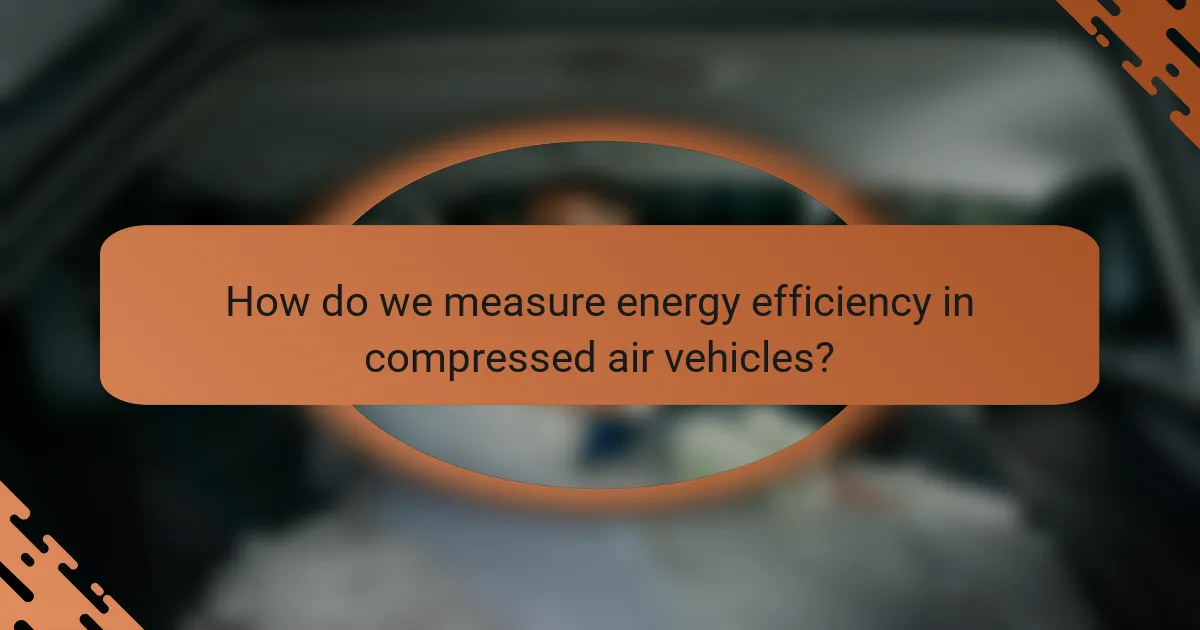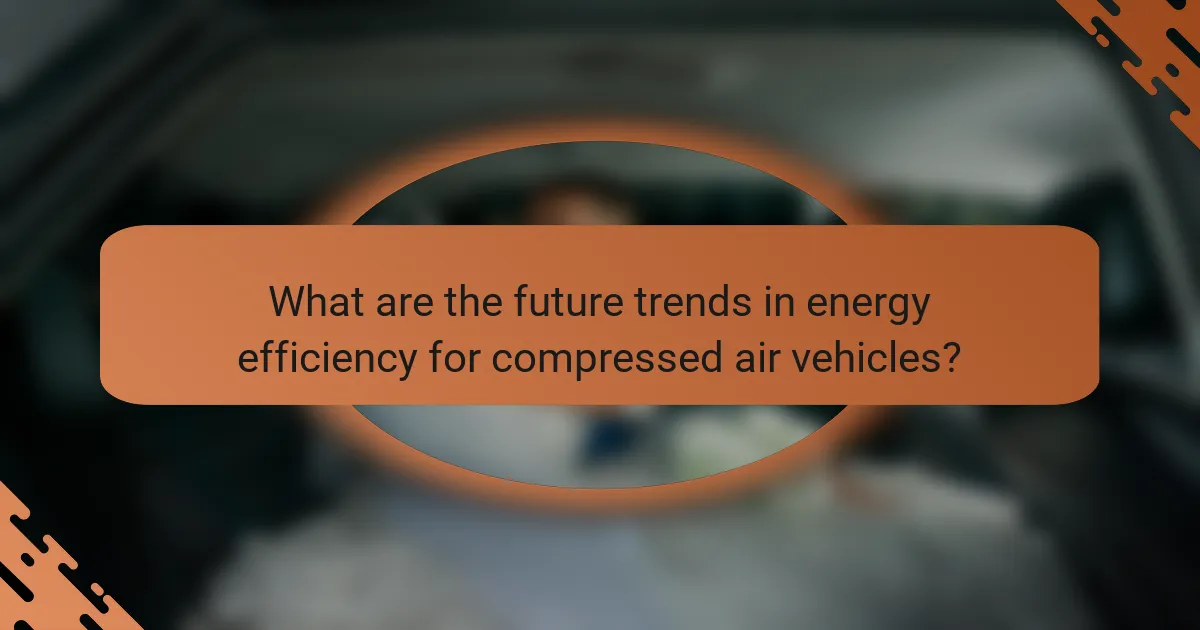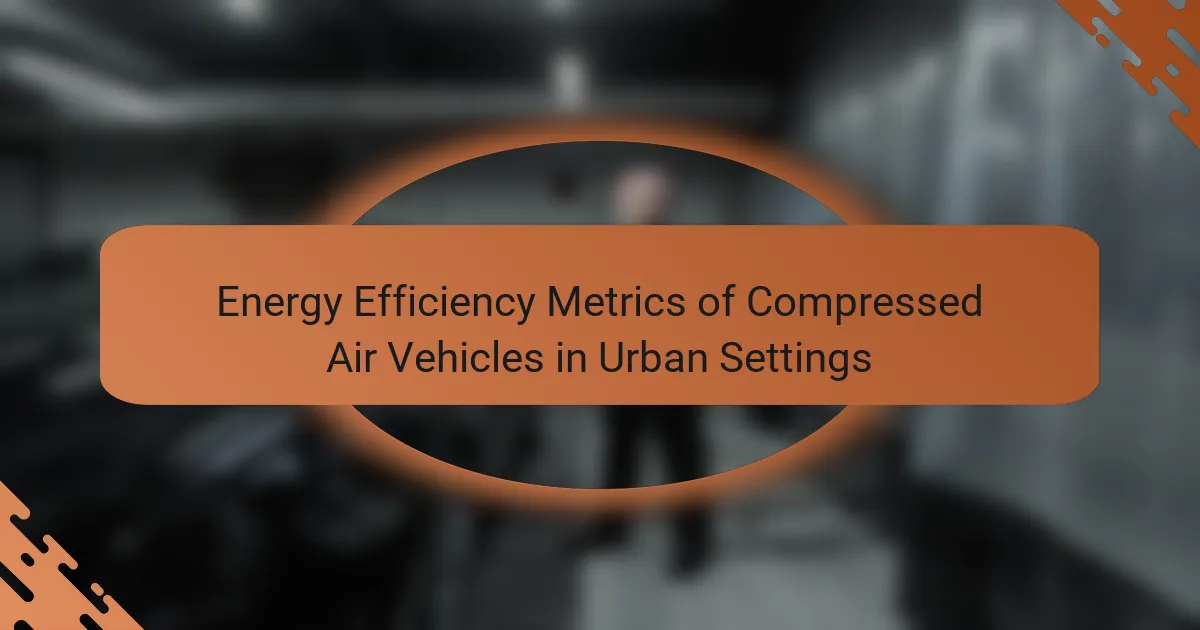Energy efficiency metrics in compressed air vehicles are critical for assessing their performance and sustainability in urban environments. These metrics include energy consumption per distance traveled, system efficiency ranging from 30% to 50%, and energy recovery rates during braking. Factors such as vehicle weight, aerodynamic design, and the pressure of compressed air significantly influence these efficiencies. Research indicates that optimized compressed air systems can achieve energy efficiencies comparable to traditional electric vehicles, with future advancements expected to enhance performance further. The article explores these metrics and trends, highlighting the importance of energy efficiency in the context of stricter urban emissions regulations.

What are Energy Efficiency Metrics in Compressed Air Vehicles?
Energy efficiency metrics in compressed air vehicles measure the effectiveness of energy usage. These metrics include energy consumption per distance traveled, typically expressed in kilowatt-hours per kilometer. They also consider the overall efficiency of the compressed air system, which can range from 30% to 50%. Another important metric is the energy recovery rate during braking, which can enhance overall efficiency. Additionally, vehicle weight and aerodynamic design impact energy efficiency. These metrics are essential for evaluating performance and sustainability in urban settings.
How are energy efficiency metrics defined for compressed air vehicles?
Energy efficiency metrics for compressed air vehicles are defined by evaluating their energy consumption relative to distance traveled. These metrics often include specific energy consumption (SEC), measured in kilowatt-hours per kilometer. SEC quantifies the amount of energy required to propel the vehicle over a given distance. Additionally, the overall efficiency of the compressed air system is assessed, which includes the efficiency of air compression and storage.
Research indicates that the efficiency of energy conversion in compressed air vehicles can vary significantly based on design and operational factors. For instance, a 2015 study by Zhang et al. found that energy losses in the compression process can exceed 30%. Thus, understanding these metrics is crucial for optimizing performance and reducing operational costs in urban environments.
What attributes are measured to determine energy efficiency?
Energy efficiency is measured by attributes such as energy consumption, output power, and thermal efficiency. Energy consumption quantifies the amount of energy used per distance traveled. Output power assesses the effective power generated relative to input energy. Thermal efficiency evaluates how well a vehicle converts energy into useful work. Additional attributes include vehicle weight, aerodynamics, and regenerative braking efficiency. These factors collectively influence the overall performance and energy efficiency of compressed air vehicles.
How do these metrics compare to traditional vehicle energy metrics?
Compressed air vehicle energy efficiency metrics differ significantly from traditional vehicle energy metrics. Traditional vehicles typically measure energy efficiency in terms of miles per gallon (MPG) or energy consumption per distance traveled. In contrast, compressed air vehicles focus on metrics like energy per kilogram of air used and the overall energy recovery during operation.
For example, compressed air vehicles can achieve energy efficiencies of approximately 60% to 70% in urban settings, compared to conventional vehicles that average around 20% to 30% efficiency due to energy losses in combustion. This higher efficiency is attributed to the lack of internal combustion processes, which waste energy as heat.
Moreover, compressed air vehicles often utilize regenerative braking systems, enhancing their energy recovery capabilities. Traditional vehicles, particularly those with internal combustion engines, do not typically integrate such systems, leading to further disparities in energy efficiency metrics.
Why is energy efficiency important for compressed air vehicles in urban settings?
Energy efficiency is crucial for compressed air vehicles in urban settings because it reduces operational costs and environmental impact. Urban areas often face high traffic congestion and pollution levels. Efficient energy use in these vehicles can lead to lower energy consumption and decreased emissions. For instance, a study by the International Energy Agency indicates that energy-efficient vehicles can reduce greenhouse gas emissions by up to 30%. Additionally, energy efficiency enhances vehicle range, allowing for longer trips without frequent refueling. This is particularly important in urban environments where charging or refueling infrastructure may be limited. Overall, prioritizing energy efficiency in compressed air vehicles supports sustainability and improves urban air quality.
What impact does energy efficiency have on urban air quality?
Energy efficiency positively impacts urban air quality by reducing emissions from energy consumption. Improved energy efficiency leads to lower fossil fuel use. This decrease results in reduced pollutants like nitrogen oxides and particulate matter. Studies show that enhancing energy efficiency can cut greenhouse gas emissions significantly. For example, the U.S. Environmental Protection Agency estimates that energy efficiency measures can reduce air pollution by up to 30%. Cleaner air contributes to better public health outcomes. Reduced air pollution also lessens respiratory and cardiovascular diseases. Overall, energy efficiency plays a crucial role in improving urban air quality.
How does energy efficiency influence urban transportation costs?
Energy efficiency significantly reduces urban transportation costs. Improved energy efficiency leads to lower fuel consumption. This reduction in fuel use directly decreases operating expenses. For instance, vehicles with higher energy efficiency can save up to 30% in fuel costs. Additionally, energy-efficient vehicles often require less maintenance. Lower maintenance needs further contribute to cost savings. According to a study by the U.S. Department of Energy, energy-efficient transportation can save cities millions annually. These savings can then be redirected to other urban infrastructure needs.
What challenges do compressed air vehicles face in achieving energy efficiency?
Compressed air vehicles face several challenges in achieving energy efficiency. One significant challenge is the energy loss during air compression. Compressing air requires substantial energy, often resulting in a lower overall efficiency. Another challenge is the limited energy density of compressed air compared to traditional fuels. This limits the range and performance of the vehicles. Additionally, thermal losses occur during the expansion of compressed air, further reducing efficiency. The need for specialized infrastructure for refueling also poses logistical challenges. These factors collectively hinder the effective implementation of compressed air vehicles in urban settings.
What are the technical limitations affecting energy efficiency?
Technical limitations affecting energy efficiency include system inefficiencies, energy conversion losses, and material constraints. Compressed air vehicles often experience energy losses during compression and storage processes. These losses can account for up to 30% of the total energy input. Additionally, the efficiency of air compression technology can vary significantly. Current compressors may not operate at optimal efficiency across all conditions. Furthermore, the materials used in compressed air tanks can limit pressure retention and increase weight. This affects overall vehicle performance and energy consumption. Lastly, the energy density of compressed air is lower than that of conventional fuels, leading to reduced range and efficiency.
How do urban infrastructure and traffic patterns impact energy efficiency?
Urban infrastructure and traffic patterns significantly impact energy efficiency. Efficient urban design reduces travel distances and optimizes traffic flow. Well-planned infrastructure can minimize congestion, leading to lower energy consumption. Studies show that cities with integrated public transport systems have reduced vehicle emissions by up to 30%. Traffic patterns, such as stop-and-go conditions, increase fuel consumption. A smoother traffic flow enhances energy efficiency in vehicles. Additionally, the presence of bike lanes and pedestrian pathways encourages alternative transport modes. These alternatives reduce reliance on fossil fuel-powered vehicles, further promoting energy efficiency.

How do we measure energy efficiency in compressed air vehicles?
Energy efficiency in compressed air vehicles is measured by assessing the energy consumed per distance traveled. This metric is often expressed in terms of energy per kilometer or energy per mile. The efficiency is calculated by dividing the total energy used to compress air and propel the vehicle by the distance covered.
Key factors include the pressure of the compressed air and the efficiency of the air motor. Higher pressures can lead to more energy efficiency, but they may also increase energy consumption during compression. Testing protocols often involve standardized driving cycles to simulate real-world conditions.
Data from studies indicate that compressed air vehicles can achieve energy efficiencies comparable to traditional electric vehicles under optimal conditions. For instance, a study published in the International Journal of Energy Research found that energy efficiency can reach up to 60% in well-designed compressed air systems.
What methods are used to assess energy efficiency in these vehicles?
Energy efficiency in compressed air vehicles is assessed using several methods. Common methods include measuring fuel consumption, evaluating distance traveled, and analyzing power output. The energy consumption can be quantified in terms of energy per distance traveled. Testing often involves controlled environments to ensure accuracy. Real-world driving conditions are also simulated to gather relevant data. Additionally, lifecycle assessments evaluate the overall efficiency from production to disposal. These methods provide insights into the operational efficiency of compressed air vehicles.
How do simulation models contribute to energy efficiency analysis?
Simulation models enhance energy efficiency analysis by providing a virtual environment to test and optimize systems. They allow for the evaluation of various scenarios without the need for physical prototypes. This leads to cost savings and reduced resource consumption. Specific metrics such as energy consumption, emissions, and performance can be assessed accurately. For instance, simulation models can predict how compressed air vehicles will operate under different urban conditions. Studies have shown that these models can identify optimal operational strategies that improve energy efficiency. Therefore, they are essential tools in the analysis and development of energy-efficient technologies.
What role do real-world testing and data collection play?
Real-world testing and data collection are essential for evaluating energy efficiency metrics of compressed air vehicles. These processes provide empirical evidence on vehicle performance in actual urban environments. Testing under real conditions reveals how factors like traffic patterns and weather influence energy consumption. Data collection allows for the assessment of energy savings compared to traditional vehicles. It also helps identify areas for improvement in vehicle design and operation. Research indicates that real-world data can lead to more accurate predictions of energy use. For instance, studies show that controlled tests often underestimate energy consumption compared to real-world scenarios. This discrepancy highlights the importance of real-world data in developing effective energy efficiency strategies.
What tools and technologies are available for measuring efficiency?
Tools and technologies for measuring efficiency include energy monitoring systems, data analytics software, and performance benchmarking tools. Energy monitoring systems track real-time energy consumption and efficiency metrics. Data analytics software processes collected data to identify trends and inefficiencies. Performance benchmarking tools compare efficiency metrics against industry standards. These tools help optimize energy usage and reduce waste. According to the U.S. Department of Energy, implementing such technologies can lead to significant energy savings in various applications.
What software tools are commonly used for energy efficiency metrics?
Software tools commonly used for energy efficiency metrics include EnergyPlus, RETScreen, and HOMER. EnergyPlus is a building energy simulation program that models energy and water use in buildings. RETScreen is a free software that assesses the energy production, life-cycle costs, emission reductions, and financial viability of renewable energy technologies. HOMER is used for optimizing microgrid design and operation, considering various energy sources and consumption patterns. These tools facilitate the analysis of energy efficiency in various applications, including compressed air vehicles. Their widespread use is supported by their ability to provide detailed simulations and assessments, which are crucial for improving energy efficiency metrics in urban settings.
How does telemetry enhance the measurement of energy efficiency?
Telemetry enhances the measurement of energy efficiency by providing real-time data collection and analysis. It enables continuous monitoring of energy consumption in compressed air vehicles. This data helps identify patterns and inefficiencies in energy use. Telemetry systems can track various performance metrics, such as pressure levels and flow rates. Accurate data allows for timely adjustments to optimize energy usage. Studies show that telemetry can improve energy efficiency by up to 20% in industrial applications. By analyzing this data, operators can make informed decisions to enhance performance. This leads to reduced operational costs and lower environmental impact.

What are the future trends in energy efficiency for compressed air vehicles?
Future trends in energy efficiency for compressed air vehicles include advancements in storage technology and system optimization. Innovations in high-pressure storage systems will enhance energy density. Improved energy recovery systems will increase overall efficiency during operation. Developments in lightweight materials will reduce vehicle weight, leading to lower energy consumption. Integration of smart technologies will optimize energy usage in real-time. Research indicates that these trends could lead to a 30% increase in energy efficiency by 2030. As cities adopt stricter emissions regulations, compressed air vehicles will become more viable in urban environments.
How is technology advancing energy efficiency in compressed air vehicles?
Technology is advancing energy efficiency in compressed air vehicles through innovative designs and improved materials. Advanced composite materials reduce weight, enhancing overall efficiency. Enhanced air storage systems increase the amount of energy stored, allowing for longer travel distances. Smart control systems optimize air usage during operation, minimizing waste. Regenerative braking systems capture energy that would otherwise be lost, improving overall energy recovery. Recent studies indicate that these advancements can increase efficiency by up to 30%. Furthermore, ongoing research focuses on developing more efficient compressors, which can significantly reduce energy consumption during air compression. These technological innovations collectively contribute to the enhanced energy efficiency of compressed air vehicles.
What innovations are on the horizon that could improve efficiency?
Innovations on the horizon that could improve efficiency in compressed air vehicles include advanced energy storage systems and lightweight materials. Advanced energy storage systems, such as high-capacity compressed air tanks, can enhance energy retention and delivery. Lightweight materials, like carbon fiber and advanced composites, reduce vehicle weight, improving overall efficiency. Additionally, smart energy management systems optimize energy use during operation. Research indicates that these innovations can lead to a 20-30% increase in energy efficiency. The development of hybrid systems combining compressed air with electric propulsion is also underway, potentially further enhancing efficiency in urban settings.
How might regulatory changes impact energy efficiency metrics?
Regulatory changes can significantly impact energy efficiency metrics for compressed air vehicles. New regulations may set stricter standards for emissions and fuel consumption. This can lead manufacturers to innovate and improve vehicle designs. Enhanced designs often result in better energy efficiency performance. For example, regulations promoting the use of lightweight materials can reduce energy consumption. Additionally, incentives for energy-efficient technologies can encourage adoption. Historical data shows that regulatory frameworks have previously led to advancements in automotive efficiency metrics. The Corporate Average Fuel Economy (CAFE) standards in the U.S. have driven improvements in fuel efficiency across various vehicle types. Thus, regulatory changes directly influence the metrics used to measure energy efficiency in compressed air vehicles.
What best practices can urban planners adopt to enhance energy efficiency?
Urban planners can enhance energy efficiency by implementing several best practices. First, they should prioritize mixed-use development. This encourages walking and reduces reliance on vehicles. Second, planners should integrate green infrastructure. Green roofs and permeable pavements help manage stormwater and improve air quality. Third, adopting smart grid technology can optimize energy distribution. This allows for better management of energy consumption.
Additionally, planners should promote public transportation systems. Efficient transit reduces the number of vehicles on the road. Implementing energy-efficient building codes is another critical practice. These codes ensure that new constructions minimize energy use. Lastly, urban planners should engage in community education. Informed citizens are more likely to adopt energy-saving practices. Each of these strategies contributes to a more energy-efficient urban environment.
How can urban design support the efficiency of compressed air vehicles?
Urban design can significantly enhance the efficiency of compressed air vehicles. Effective urban planning includes the integration of dedicated lanes for these vehicles. This reduces congestion and allows for smoother travel. Additionally, strategically placed charging stations can support the refueling needs of compressed air vehicles. Urban layouts that prioritize public transport can minimize the overall traffic volume. Green spaces and pedestrian-friendly areas can reduce the reliance on traditional vehicles. Implementing smart traffic management systems can optimize routes for compressed air vehicles. Research indicates that cities designed for alternative transport modes can improve energy efficiency by up to 30%. These design elements collectively create an environment conducive to the efficient operation of compressed air vehicles.
What strategies can be implemented to promote the use of efficient vehicles?
Promoting the use of efficient vehicles can be achieved through various strategies. Incentives such as tax breaks or rebates encourage consumers to purchase efficient vehicles. Educational campaigns raise awareness about the environmental benefits and cost savings of efficient vehicles. Infrastructure development, like charging stations for electric vehicles, supports their use. Government regulations can mandate fuel efficiency standards, pushing manufacturers to produce better vehicles. Partnerships with businesses can promote fleet transitions to efficient vehicles. Public transportation upgrades can demonstrate the advantages of efficiency to a broader audience. Research indicates that cities implementing these strategies see increased adoption rates of efficient vehicles. For instance, a study by the International Council on Clean Transportation found that incentives significantly boost electric vehicle sales.
Energy efficiency metrics of compressed air vehicles focus on evaluating energy consumption, overall system efficiency, and energy recovery rates in urban environments. Key attributes measured include energy consumption per distance traveled, specific energy consumption, and the impact of vehicle design factors such as weight and aerodynamics. The article compares these metrics to traditional vehicle energy measurements, highlights the importance of energy efficiency for reducing operational costs and emissions, and discusses challenges faced by compressed air vehicles. It also explores technological advancements and regulatory impacts that could enhance energy efficiency in the future.
